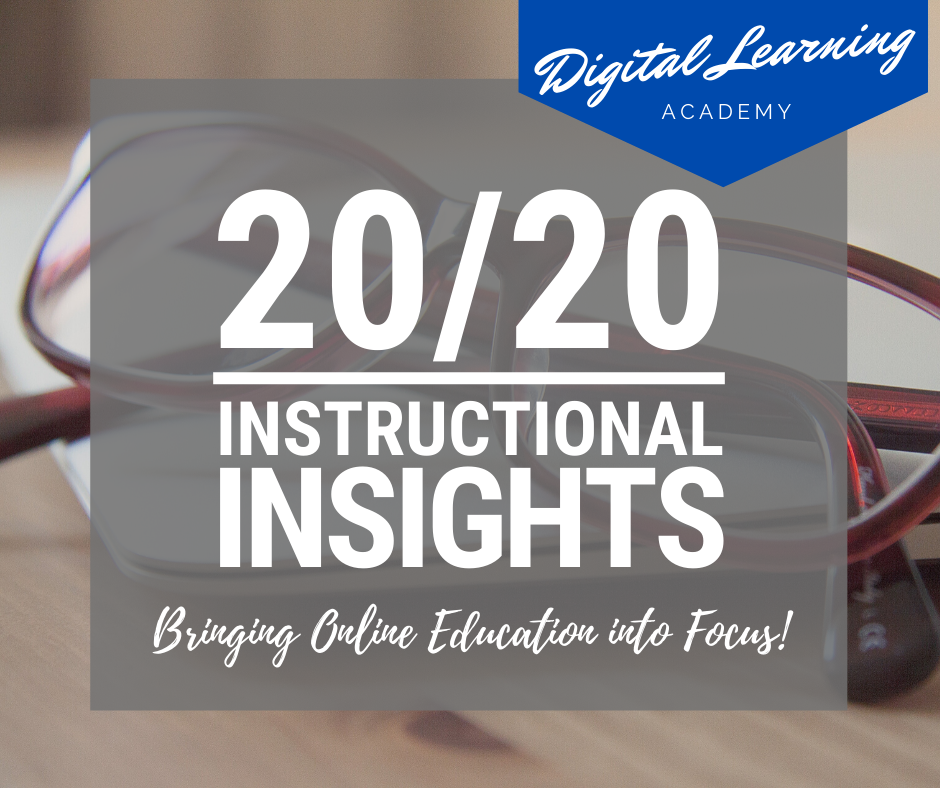Touch Base with Your Online Students Using Formative Assessment Three Surveying Tools to Help You Better Understand Your Online Students Wow! It has been a wild past few weeks, hasn’t it? With all the whirlwind events that have been happening across our nation and particularly in our education system, do you feel like you have lost touch with your students? This Instructional Insight was originally going to be all about formative assessment and how to effectively use it to monitor your students’ learning progress. With so many instructors working so hard to get their courses online, we have shifted our focus slightly. In this Insight, will now be focused on how you can use formative assessment type tools to reach out and check on how your students are doing during this transition to learning online. You can use formative assessment tools to check on how your students are doing during this transition to learning online Show Me the Examples Below! With so many in-person courses now online, it can be easy to feel like it has lost some of the human element. However, there are so many ways to make online teaching and learning extremely personal. Check out 6 Tips to Move Your In-Person Course Online During the Coronavirus to find ideas and tool recommendations to aid you in your online transition. Disclosure: This post contains affiliate links and I could earn a small commission at no additional cost to you should you make a purchase using them. All recommendations are based on my personal experience. Table of Contents The Power of Formative Assessment Online Assessment is an essential part of the learning process both online and in-person. There are two key assessment types. Explore the definitions of formative and summative assessment below: Formative Assessment Formative assessment is conducted throughout the learning process to monitor student progress towards achieving a learning objective. When done correctly, it can also foster student learning by helping students identify their strengths and weaknesses. Once a student and an instructor understand what are areas of learning weakness, those weaknesses can be addressed and overcome. Summative Assessment Summative assessment is administered once a learning process is complete. This can range from a single course or an entire curriculum. This assessment serves as a final and complete evaluation of the students’ achievement of a learning objective. Ideally, the summative assessment is the sum of all the smaller formative assessments. We mention how vital formative assessment can be to our students during the learning process. Still, it can also be a powerful tool to get an accurate read on how your students are doing during this transition. We love the definition of formative assessment above because it emphasizes assessing the students during the learning process; this can mean so many things! Yes, it is essential to evaluate students on the academic aspects of the learning process, but it can also mean assessing the physiological and emotional aspects of the learning process. During this crazy time, more than ever, it is so crucial that you take the time to get to reacquainted with your students as they are now your online students. How are they handling now having to learn online? What resources do they have available to them? Do they know how to contact you or where to go to find their course materials? When you are teaching in-person, it is easy to pick up on social cues that clue you in on how your students are doing. In the online format, those cues are no longer easily observed. That is when formative assessment can come into play. Send out a quick survey to see how your students are doing, and this can provide you with valuable insight into how your instruction is going and if anything needs to be adjusted. Do not forget, one of the reasons for conducting a formative assessment is to use the data to help you better adjust your instruction to meet the needs of your students. If your students are not responding well to an aspect of your online instructor, take their feedback, and adjust! Who knows, they could give you some great ideas for what works well in online teaching! Introduction to Online Teaching Masterclass Fall 2022 Cohort Early Registration We are opening registration early for the fall 2022 semester cohort! Save your seat now and don’t miss out on this opportunity to gain a better understanding of foundational online teaching best practices. Early registration and early-bird pricing end 8/7/22! Clink the link below to learn more. Claim Your Seat Now! S A L E ! Examples of Formative Assessment Using Three Popular Online Surveying Tools To give you a clearer idea of how to use a formative type assessment to evaluate how your students are doing with the transition to online learning, we have made a few examples for you to check out! Click the links below to explore the different online assessment tools great for formative assessments. All the examples below ask similar questions; they are just presented slightly differently among the tools. Google Forms (included if you have a Gmail account) Go Formative (free team premium plan upon request) Poll Everywhere (free 90-day premium plan) Check In With Your Students Today Now it is time to take action and send out a quick survey out to your students to see how they are doing! Want a copy of the surveys above? Great, we are thrilled to share what we have created in hopes of saving you time. Please submit your email address below, and we will send you links to copy the surveys we have created. Once you have received your copy of the surveys and sent one out to your students, give us a shout-out on our Facebook page, letting us know it was helpful! Share on facebook Facebook Share on linkedin LinkedIn Share on pinterest Pinterest Share on email Email Share on twitter Twitter Once you have received your copy of the surveys and sent one out to
How to Move Your Course Online During the Coronavirus
6 Tips to Help You Transition Your In-Person Class Online During the Coronavirus Outbreak Institutions across the nation are actively preparing to move their on-campus classes into an online format as a measure to prevent the spread of the Coronavirus. For many, this migration from in-person teaching to online teaching can be a daunting task, but it does not have to be! With these 6 helpful tips, you can easily move your in-person class online successfully. The tips below include online teaching strategies, tools that can aid in teaching online, and important things to consider as you make this transition. It is important that before you begin to transition your in-person class to an online environment, that you know the resources that are available to you through your institution. There is no sense in reinventing the wheel here! Most institutions have a team of Instructional Designers, Educational Technologists, and Distance Education Staff that are busy at work preparing to help you. If you are not currently familiar with what technologies your institution has, now is the time to know what is available to you and your students. Here are a few questions you should know the answers to as you begin transiting your course online: What Learning Management System (LMS) do we use at this institution? Where can I find LMS resources so that I can learn how to use the platform? What third-party technology tools are available to me to use? What virtual communication or video conferencing tools are available to me and my students? Are there any trainings available to aid me in learning how to best deliver my course online? What are institutional policies regarding the use of third-party technology tools? After you have read the tips and recommendations below it will be time to get started transitioning your in-person course online. This starts by making a plan, then communicating your plan to your students, putting your plan into action, and then constantly communicating with your students so you know what is working and what needs adjusting. So here we go! Disclosure: This post contains affiliate links and I could earn a small commission at no additional cost to you should you make a purchase using them. All recommendations are based on my personal experience. Table of Contents #1 Embrace Virtual Communication & Office Hours Communication is going to be the key to success over these next few weeks! Not only are you having to learn a new way of teaching but your students are also having to learn a new way of learning. As we mentioned above, make a plan and then let your students know what that plan is. Something we all take for granted with in-person classes is how easy it is to communicate the little details with our students without really even thinking about it. As you transition to communicating strictly online, you will have to be much more diligent and thoughtful with how and what you communicate with your students. They will not be able to read your mind so you must tell them everything they will need to know and do to continue to be successful in your, now, online course. Lucky for you and your students, communicating online has never been easier! Here are a few tools that make communicating online a breeze: Zoom: we will mention this tool often in this article. Zoom is an amazing video conferencing tool that will allow you video chat, share screens, record sessions, and save and share recordings. Google Hangouts: also a great video and chat communication tool. If your institution uses Google Suites, your students may already be familiar with the tool and its functionality. Microsoft Teams: is an easy to use communication platform that allows for ongoing chat sessions, video and audio calls, file share, and even the use of GIFs. If your institution uses Outlook or Office365 you may have access to this tool. Using one of the tools above, try hosting an open office hour session with your students. This would allow you and them to become comfortable using the new tool to communicate with each other and give them an opportunity to ask you questions. Showing your students that you are still very available to them will help ease their worries and yours too! #2 Change up Your Lecture Style Say goodbye to the lecture hall, and say hello to giving lectures in your sweatpants! You’ll learn that one of the great things about teaching online is the ability to do it from wherever and whenever you want. This means you can give your lecture from the comfort of your couch late at night or first thing in the morning while sitting in our favorite coffee shop. One major logistic to keep in mind when making this transition from in-person to online is that your course may need to become more asynchronous. Meaning your students may not be online the exact same time you are but they still need to be able to learn. Before, you gave your lecture every Monday and Wednesday at the same time at the same place and your students were expected to be there. This is an example of synchronous learning. However, your students may now need more flexibility when it comes to learning online. We would still encourage you to give “live” lectures using the tools listed below, but we would also highly recommend that you record your lectures so that students can still access the information even if they were not able to join the live session. Synchronous Learning A learning event in which a group of students are engaging in learning at the same time. Asynchronous Learning The act of facilitating learning outside of the constraints of time and place among a group of people. The tools listed below are capable of live video and audio conferencing, chat, and screen share. They also have the ability to be recorded so that students can watch your “live” lecture at their
All About 20/20 Instructional Insights
Hello & Welcome! Share on facebook Share on twitter Share on linkedin Share on pinterest Share on email Digital Learning Academy (DLA) is an up-and-coming resource site for online instructors. The purpose of the 20/20 Instructional Insights is to provide you, the online instructor, with concise and applicable focus points. These focus points are designed to help you examine the instructional strategies you use and to provide you with easy to apply action steps to enhance your online instruction in the year 2020. 20/20 Instructional Insights are designed to help you better: Focus on the best components of your online instruction Give you clarity on tough concepts when it comes to teaching online Enhance your vision of the future of your online courses While these focus points will be geared towards instructors teaching online in the higher education setting, our hope is that the information will also be valuable to anyone involved in online learning. Subscribe to receive our 20/20 Insights below. Each week DLA will publish a new 20/20 Instructional Insight focused on a topic relevant to that specific time in the semester. You can find all Insights here and on our Facebook page. Focus Points Why Should You Follow DLA’s 20/20 Instructional Insights? We are excited to start sharing our enthusiasm for online learning with you. We hope you will consider DLA to be one of your go-to resources as you navigate online instruction. That is why we have worked hard to ensure all our 20/20 Insights are founded in the latest educational research and important trends in online teaching and learning. Our Insights will be crafted to be clear and concise for quick reading. We know how important your time is and we appreciate you spending it with us! Information is great. Information and action is even better! That is why in each Insight we will provide you with relevant action steps that you can easily apply to your online instruction that day. Finally, DLA is busy at work creating resources just for you. Keep an eye out for downloadable resources such as editable templates, reference guides, and instructional videos. Everyone loves a freebie! We will also be offering professional development courses in Summer 2020 that will provide online instructors with everything they need to successfully teach in the online learning environment. Check out DLA’s Courses Take Action Now that you know a little about us, we would love to hear from you! With Spring Break just around the corner, what better time for reflection and refocus. Our action challenge for you this week is to take a moment to look at your online course(s). What is going well? What is something that you would like to improve in your online instruction? What has been your biggest challenge this semester? What has proven to be an effective instructional strategy for you? We would love to hear your thoughts as you reflect on your online courses. Your thoughts and feedback can help us provide more information and resources that are relevant to you. Please feel free to respond by posting in the comments below, on our Facebook page, or by shooting us a quick message – we would love to hear from you. Next Week Stay tuned! Next week we will be covering how to use formative assessments to better get a pulse on what your learners are thinking and feeling about their online learning experience. Don’t miss a thing, please subscribe below to receive DLA’s latest 20/20 Instructional Insights. Please also Like and Share our DLA Facebook page. Thanks and we look forward to “seeing” you next week! Share on facebook Share on twitter Share on linkedin Share on pinterest Share on email




